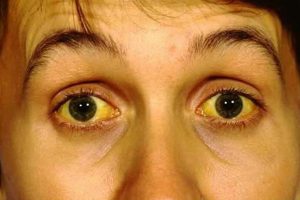Gilbert’s syndrome is a congenital hereditary disease in which the exchange of bilirubin is partially disturbed in the body. Outwardly, this is sometimes manifested by mild jaundice. The condition itself is not dangerous and does not require treatment, but it increases the risk of some pathologies of the hepatobiliary system, especially gallstone disease. Read more about the disease and how to neutralize its role as a risk factor for other diseases, read our material.
What is Gilbert’s syndrome
Gilbert’s syndrome (familial cholemia, constitutional hyperbilirubinemia) is a hereditary disease in which an excess amount of indirect bilirubin accumulates in the blood. This substance is responsible for the appearance of jaundice. The syndrome itself can hardly be considered a disease, since it does not cause any subjective sensations, and jaundice may not appear at all. Histologically, the liver of people with Gilbert’s syndrome is healthy, the changes are insignificant. Despite this, statistically, patterns were found according to which people with Gilbert’s syndrome increase the risks of certain diseases and at the same time reduce the risks of others, which patients need to be aware of.
Gilbert’s syndrome is the most common hereditary liver disease.
The probability of transmission of the disease by inheritance depends on the genotype of the parents and can be 0, 25, 50 and 100%.
The disease first makes itself felt at the age of 12 to 30 years.
Most often, treatment is not necessary.
The combination of Gilbert’s syndrome with other liver diseases can complicate their course.
Symptoms of Gilbert’s syndrome
The main symptom that betrays the disease is the recurrent yellowness of the sclera, the skin of the palms and feet, the auricles and the nasolabial triangle. The onset of symptoms is probabilistic. Usually occurs during physical exertion, emotional stress, fasting, menstruation, or an infectious disease. Often, the syndrome does not give symptoms at all, then it can be suspected only by accident – having found an excess of the normal value of the concentration of indirect bilirubin in the blood.
Of the more rare symptoms, the following can be distinguished:
Weak soreness and a feeling of heaviness in the right hypochondrium.
Bloating.
Nausea, decreased appetite, belching, a feeling of bitterness in the mouth – the phenomenon of dyspepsia.
Stool disorders: constipation or diarrhea.
Increased fatigue, dizziness, decreased mood – asthenic-vegetative syndrome.
The formation of age spots on the skin and xanthelasm of the eyelids.
However, the listed symptoms can be a consequence of other diseases and they can be accidentally attributed to the manifestations of Gilbert’s syndrome. In addition, studies¹ have shown that these symptoms are not directly related to elevated bilirubin levels.
Treatment for Gilbert’s syndrome
In the absence of symptoms, Gilbert’s syndrome does not require special treatment. But in the case of pronounced symptoms, therapeutic measures are taken depending on its severity and laboratory parameters.
In case of exacerbation, first of all, attention is paid to diet. Long breaks in food are prohibited, drink should be plentiful. It is recommended to exclude from the diet:
Fatty varieties of beef, lamb, pork, poultry (goose, duck), fish (sturgeon, catfish), as well as broths based on them.
Coffee, cocoa, cold drinks.
Confectionery with cream, chocolate, ice cream.
Fresh bakery products from butter dough.
Sour fruits and berries.
Mushrooms, sorrel, spinach, pickled vegetables.
Canned food, smoked products.
Mustard, horseradish, pepper.
Legumes.
Physical activity and sun exposure are minimized.
Drug treatment
The list of drugs used is small. Assign:
Phenobarbital https://en.wikipedia.org/wiki/Phenobarbital. The drug has an inducing effect on UDP-glucuronyltransferase, the activity of which is reduced in case of disease. Thus, they try to reduce the concentration of bilirubin in the blood.
Lactulose and dioctahedral smectite. These funds are prescribed in order to normalize the bowel function and adsorption of bilirubin metabolic products.
Ursodeoxycholic acid. This substance is part of the bile and provides its liquid state. The drug is used to prevent gallstone disease.
Additionally, vitamins can be prescribed (vitamins A, E, vitamins of group B, folic acid) and remedies for the correction of dyspeptic syndrome (aluminum hydroxide, magnesium hydroxide, domperidone, etc.)
It should be emphasized that treatment is usually prescribed to patients with concomitant diseases or pronounced symptoms. Usually drug treatment is not required, so you should not try to take these drugs on your own. The need for this can be dictated exclusively by the attending physician.
